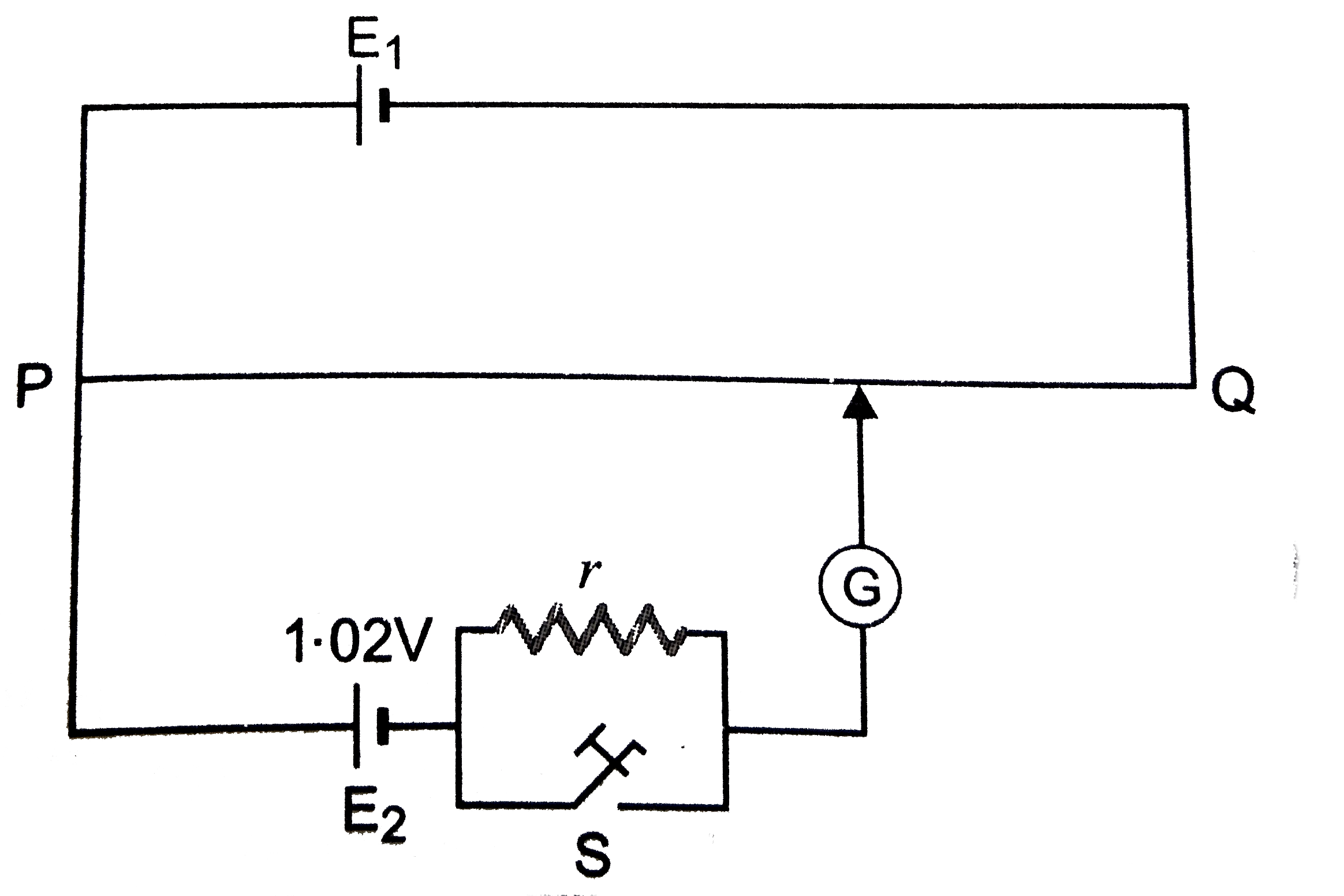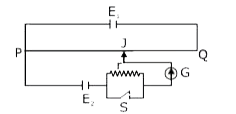Potentiometer wire of length is connected to a standerd cell . Another cell, of emf is connected with a resistance and a switch open, null position is obtained at a distance of from Calculate (i) potential gradient of the potentiometer wire and (ii) emf of the cell (iii) when swich closed will mull point move toward or toward ? Given resion for your answer ?

The correct Answer is:
(a) potential gradent
(b) emf of the cell
(c ) When swich is closed no current is drawn from the cell there is no shift point depends opon the potential gradent along the potentimeter wire [which depends upon the emf of battery and resistance of potentiometer wire circuit and length of potentiometer ] and emf of the cell which does not change when swich is closed
Topper's Solved these Questions
- CURRENT ELECTRICITYBook:PRADEEPChapter:CURRENT ELECTRICITYExercise:Jee (main and advance)
Explore 4 Videos
- CURRENT ELECTRICITYBook:PRADEEPChapter:CURRENT ELECTRICITYExercise:Interger Type
Explore 2 Videos
- CURRENT ELECTRICITYBook:PRADEEPChapter:CURRENT ELECTRICITYExercise:Value based
Explore 2 Videos
- COMMUNICATION SYSTEMSBook:PRADEEPChapter:COMMUNICATION SYSTEMSExercise:MODEL TEST PAPER-2
Explore 9 Videos
- DUAL NATURE OF RADIATION AND MATTERBook:PRADEEPChapter:DUAL NATURE OF RADIATION AND MATTERExercise:Exercise
Explore 191 Videos
Similar Questions
Potentiometer wire PQ of 1m length is connected to a standard cell E1. Another cell E2 of emf 1.02V is connected with a resistance r and a switch S as shown in the circuit diagram. With switch S open, the null position is obtained at a distance of 51cm from P.
(i) Calculate the potential gradient of the potentiometer wire.
(ii) Find the emf of cell E1.
(iii) When switch S is closed, will the null point move toward P or toward Q? Give reason for your answer.

View SolutionA cell of e.m.f. 2 V and negligible internal resistance is connected in series with a potentiometer wire of length 100 cm. The e.m.f of the Leclanche cell is found to balance on 75 cm of the potentiometer wire. The e.m.f. of the cell is
View Solution
Knowledge Check
A potentiometer wire PQ of 1 m length is connected to a standard cell E1 . Another cellE2 of emf 1.02 V is connected with a resistance ‘r’ and switch S (as shown in figure). With switch S open, the null position is obtained at a distance of 49 cm from Q. The potential gradient in the potentiometer wire is:
 A0.03 V/cmB0.02 V/cmC0.04V/cmD0.01 V/cm
A0.03 V/cmB0.02 V/cmC0.04V/cmD0.01 V/cmThe potential gradients on the potentiometer wire are V1 and V2 with an ideal cell and a real cell of same emf in the primary circuit, then
AV1=V2BV1>V2CV1<V2DV1≤V2AB is a potentiometer wire of length 100cm and its resistance is 10ohms. It is connected in series with a resistance R=10ohms and a battery of e.m.f. 2V and negligible internal resistance. If a source of unknown e.m.f. E is balanced by 40cm length of the potentiometer wire, the value of E is
 A0.8VB1.6VC0.08VD0.16V
A0.8VB1.6VC0.08VD0.16V
A potentiometer wire of length 1000 cm has a resistance of 10 ohms. It is connected in series with a resistance and a cell of e.m.f 2 volts and of negligible internal resistance. A source of e.m.f 10 millivolts is balanced against a length of 40 cm of the potentiometer wire. What is the value of the external resistance?
View SolutionPotentiometer wire of length 1m is connected in series with 490Ω resistance and 2V battery. If 0.2mVcm is the potential gradient, then resistance of the potentiameter wire is approximately
View SolutionA potentiometer wire , 4 m long and having a resistance of 10 Ω, is connected in series with an external resistance of 38Ω and a cell , of emf 2 V and internal resistance 2Ω. Calculate the potential gradient along the wire.
View SolutionA cell of e.m.f. 4 V and of negligible internal resistance is connected in series with a potentiometer wire of length 400 cm. The e.m.f. of a Leelanche cell is found to be balacned at 150 cm from the positive end of the potentiometer wire. What is the e.m.f. of the Leclanche cell ?
View SolutionA cell of e.m.f. 2 V and negligible internal resistance is connected to a potentiometer wire of resistance 10Ω and length 4 m. The potential difference per unit length (potential gradient ) of the wire is
View Solution

